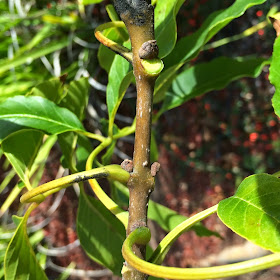Leaves are deciduous, opposite, pinnately compound, 6-9" long, with 7 elliptical to broadly lanceolate leaflets. Leaflets are about 1-2" long, having various amounts of serrations on the margins, may or may not have hair on the lower surface, but they usually do in the spring.
Twigs can be stout or thin on weak lower branches. Usually squared at the nodes. Buds are covered with hairs, copper colored, with the terminal being larger than the others. Usually three buds in the terminal location. Leaf scars are one key to correct identification. The bud sits on top of the semicircular scar.
Plants are dioecious, male and female. Developing early spring along with the foliage, usually slightly earlier. Many selections are males.
Females.
Fruit is a narrow, straight samara, borne in large clusters, green turning brown and falling about the same time as the leaves.
Bark is smooth, gray but eventually darker, furrowed, scaly or ridged.
Misidentification:
Ash trees can be tough to sort out. The bud and leaf scar are one important characteristic. Leaflet shapes, margins, bud color are other things to look at.
Location:
Aptos 125 Heather Terrace - Aegis Living









